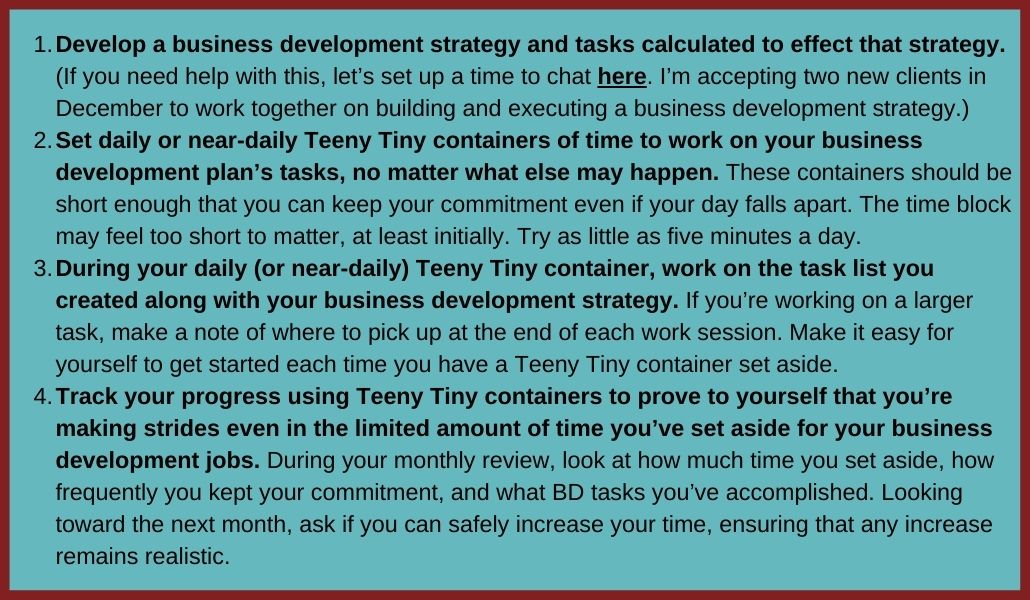Your Decisions Determine Your Business Development Success.
Making and executing decisions is a key part of practicing law. Litigators decide what strategy to follow on a case; negotiators decide where to stand firm and where to compromise; partners decide which associates are right for an assignment and advancement; patent lawyers decide which features of an invention to claim… And so on.
In fact, decision-making is one of the first practice skills we learn in law school. Did you ever witness the disaster that often followed when a student didn’t stick with an argument about whether and why a case was correctly decided? The professor would show that changing lanes repeatedly often leads to flaccid, half-baked arguments that fall apart. The student under questioning would discover just how accurate the phrase “hot seat” can feel, ending up exhausted and embarrassed. Sure, sometimes we make a mistake and have to correct it, but making and remaking a decision burns time and energy and rarely ends well.
Decision-making plays an important role in business development in two essential ways:
- Deciding to focus on BD and grow a book of business
- Deciding on a course of BD action and following through
Let’s look at each of these decisions and how they may fall by the wayside, undoing potential success along the way.
Deciding to focus on BD and grow a book of business
Most of us didn’t enter practice thinking, I can’t wait to do business development! Instead, something happens that prompts us to turn our attention from billable work to the process of bringing in that work. And we decide to focus on BD and growing a book of business… or do we?
The word decide comes from the Latin decidere, which is a combination of two words that mean to cut off. (See the brief discussion about the meaning of the word decide.) In other words, to decide on a course of action is to cut off other options.
But when it comes to focusing on business development, many lawyers reverse course when they get busy with billable work and deadlines. Far from having cut off the option of not focusing on BD, these lawyers justify why they have to step away from BD “for now” until they get past a busy period. Sometimes they never resume BD focus, and sometimes they repeatedly dip in and out of focus. In either case, they never come close to reaching momentum.
Deciding that things are just too busy to focus on business development feels like a valid decision, perhaps even a necessary one. After all, you can’t slack on billable work to chase new work, and meeting deadlines is crucial. This can feel like an inescapable Catch-22, but there is a solution.
Decide on small, discrete steps you can take to keep your business development work going even when you’re busy, and then do them. These steps may feel too small to matter, but they’ll keep your BD work alive until you can resume focusing on it. Read more about how to use Teeny Tiny containers to accomplish your BD goals even when you’re too busy to do as much as you’d like.
When you carve out a “no matter what happens” block of time for business development, even if it’s just a few minutes, you’re affirming that BD is a top priority for you. You’re executing the decision you made to focus on BD and grow your book.
Deciding on a course of BD action and following through
When you began focusing on business development, you probably created a BD plan to execute an underlying strategy. (If that isn’t how you began, we should talk so you can set yourself up for success in 2023.) Your plan likely includes several buckets of activities, such as networking to meet potential clients and referral sources, following up with key contacts so that you remain top-of-mind, writing and speaking to build your professional profile, and so on. You started executing your plan, but something happened…
Perhaps you didn’t see the results you were expecting or perhaps you had a new idea that seemed like a better approach. Maybe a colleague mentioned something that led to new business, or you read an article with some fresh ideas, and you think you should shift your plan to incorporate those ideas. After all, you don’t want to waste time on something that isn’t working when there’s something better to try, right? Well, yes and no.
Landing new business takes time. How long this takes depends on a wide variety of factors, but most lawyers find that establishing a flow of new business takes longer than they’d dreamed it might.
Business development success lies in having a solid strategy and consistently executing actions to affect the strategy. It takes time to see the results of your actions, but it also takes time to put in the effort necessary to even hope to see results. Frustrating but true.
I recommend my clients work on their business development plan for three months and then evaluate what results they’re seeing. Sometimes that’s measured in new business, but especially for more high value/low volume practices, that’s measured in a wider network, in more conversations about business and how to get in line to pitch a new matter. The three-month evaluation is about whether you’re seeing results, not whether you’re getting new business. If there are no results, then we have to evaluate whether it’s the plan/execution that’s faulty and a change is required, whether skills development is needed, or whether there’s something else going on. If there are some results, I counsel my clients to keep going.
The second evaluation period comes at six months. Are you seeing measurable results that indicate that you’re on the right track? Have you been invited to pitch or join a potential client’s panel of law firms? Have you built inroads in a group of potential clients and begun to develop strong relationships? Are you speaking on a bigger stage (which might be literally speaking at larger gatherings or possibly in smaller groups of carefully targeted contacts)? Have your relationships with your A-list deepened?
After engaging in this analysis, the next question is whether the results are strong enough to indicate that you should stay the course. It’s a more quantitative time in vs. results out inquiry. Finally, you look at the list you’ve been keeping of other ideas and determine whether you should stop something you’re doing and try one of them instead.
If you try a new idea before giving your old plans a fair trial, and especially if you do that over and over, you won’t hit momentum and you will undercut any potential of harnessing the power of consistent execution. Instead, you’ll jump from one plan to another then to another, expending lots of energy and investing lots of time and getting few results.
The Bottom Line regarding your BD plan
Take consistent action with your business development plan. Decide to engage in BD with consistency, and you’ll see results. But if you keep changing plans midstream and discover that your results are lacking, question the strength of your decision first.


